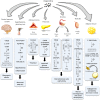Overview of the Pathophysiological Implications of Organotins on the Endocrine System
- PMID: 29615977
- PMCID: PMC5864858
- DOI: 10.3389/fendo.2018.00101
Overview of the Pathophysiological Implications of Organotins on the Endocrine System
Abstract
Organotins (OTs) are pollutants that are used widely by industry as disinfectants, pesticides, and most frequently as biocides in antifouling paints. This mini-review presents the main evidences from the literature about morphophysiological changes induced by OTs in the mammal endocrine system, focusing on the metabolism and reproductive control. Similar to other toxic compounds, the main effects with potential health risks to humans and experimental animals are not only related to dose and time of exposure but also to age, gender, and tissue/cell exposed. Regarding the underlying mechanisms, current literature indicates that OTs can directly damage endocrine glands, as well as interfere with neurohormonal control of endocrine function (i.e., in the hypothalamic-pituitary axis), altering hormone synthesis and/or bioavailability or activity of hormone receptors in the target cells. Importantly, OTs induces biochemical and morphological changes in gonads, abnormal steroidogenesis, both associated with reproductive dysfunctions such as irregular estrous cyclicity in female or spermatogenic disorders in male animals. Additionally, due to their role on endocrine systems predisposing to obesity, OTs are also included in the metabolism disrupting chemical hypothesis, either by central (e.g., accurate nucleus and lateral hypothalamus) or peripheral (e.g., adipose tissue) mechanisms. Thus, OTs should be indeed considered a major endocrine disruptor, being indispensable to understand the main toxic effects on the different tissues and its causative role for endocrine, metabolic, and reproductive dysfunctions observed.
Keywords: endocrine disruptor; hypothalamus–pituitary axis; impossex; metabolic disrupting chemicals; obesogen; tributyltin; triphenyltin.
Figures


References
-
- Hoch M. Organotin compounds in the environment – an overview. Appl Geochem (2001) 16:719–43.10.1016/S0883-2927(00)00067-6 - DOI
Publication types
LinkOut - more resources
Full Text Sources
Other Literature Sources

